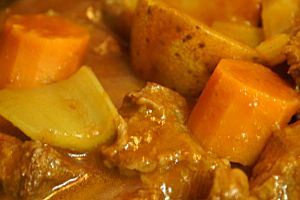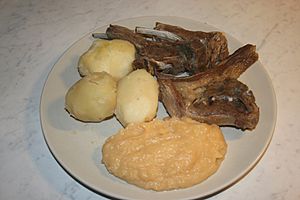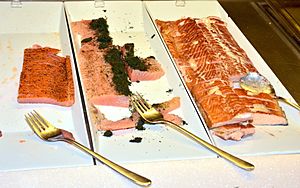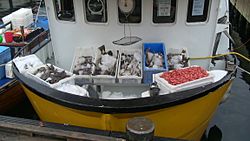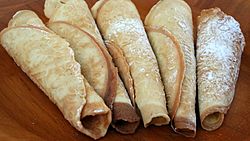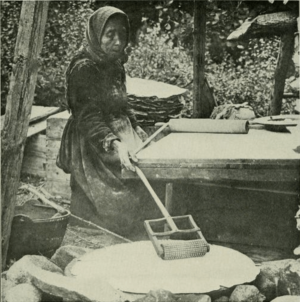Norwegian cuisine facts for kids
Norwegian food traditions are mostly based on ingredients found in Norway's mountains, wild areas, and along its long coast. It's different from food in other parts of Europe because it uses more wild game and fish. Many traditional dishes were created to preserve food for the long, cold winters.
Today, Norwegian cooking still has strong roots in tradition. However, it's also been influenced by foods from all over the world. Things like pasta, pizza, and tacos are now as common as meatballs and cod for everyday meals.
Contents
Typical Meals in Norway
Most Norwegians eat three or four meals each day. This usually includes a cold breakfast with coffee, a cold lunch (often packed) at work or school, and a hot dinner at home with family. Sometimes, people might have a small, cold meal in the late evening, like a simple sandwich.
Breakfast (frokost)
A basic Norwegian breakfast often has bread, brunost (brown cheese), and milk. In the past, this meal also included porridge, like grøt (made from flour, rice, or grains boiled with milk) or rømmegrøt (made with sour cream).
Lunch (lunsj)
For many Norwegians, a weekday lunch is usually simple. It often consists of open-faced sandwiches called matpakke. Each slice is separated by small sheets of wax paper called mellomleggspapir. Larger open-faced sandwiches with many toppings are known as smørbrød.
Cafeterias often offer salad bars, warm meals, and dairy products like yogurt and skyr.
Dinner (middag)
Norwegians usually eat dinner between 4 PM and 7 PM. This is the main meal of the day. It typically includes foods rich in carbohydrates, like potatoes, and protein-rich foods, such as meat or fish.
Evening Meal (kveldsmat)
Norwegians often have a very small meal before bed. This meal might be similar to what they eat for breakfast.
Meat Dishes
Norway has many different kinds of preserved meats and sausages, depending on the region. These are sometimes served with sour cream dishes and flatbread. A special treat is fenalår, which is a lamb's leg that has been slowly cured. Another is morr, usually a smoked sausage.
Lamb and mutton are very popular in autumn. They are often used in fårikål, a mutton stew with cabbage. Pinnekjøtt (steamed cured mutton ribs) is a traditional Christmas dinner in western Norway. An unusual dish is smalahove, which is a salted or smoked lamb's head.
Other meat dishes include:
- Kjøttkaker: These are large patties made from ground beef, onion, salt, and pepper. They are usually served with a brown sauce, potatoes, and stewed peas or cabbage and carrots. Lingonberry jam is a common side.
- Kjøttboller (Meatballs): These are a simpler version of Swedish meatballs. They are served with mashed potatoes and cream sauce.
- Svinekoteletter (Pork chops): These are simply cooked and served with potatoes and fried onions or other vegetables.
- Svinestek (Roast pork): This is a typical Sunday dinner. It comes with pickled cabbage, gravy, vegetables, and potatoes.
Most good cuts of meat are roasted, just like in other cuisines. Side dishes change with the season and what goes well with the meat. Roast leg of lamb is a classic for Easter. Game meats are often roasted for special events.
- Lobscouse: This is a stew made with cooked meat and different vegetables like potatoes, carrots, swede (rutabaga), and onion. Lobscouse is often eaten with flatbread.
- Fårikål: This mutton stew is Norway's national dish. It's easy to make: cabbage and mutton are layered in a pot with black peppercorns and salt. Water is added, and it's simmered until the meat is very tender. Potatoes are served on the side.
- Stekte pølser (Fried sausages): Fresh sausages are fried and served with vegetables, potatoes, peas, and sometimes gravy.
- Syltelabb: This dish is usually eaten around Christmas. It's made from boiled, salt-cured pig's trotters. People traditionally eat them with their fingers as a snack. They are often served with beetroot, mustard, and fresh bread or flatbread.
- Pinnekjøtt: This main course is made from lamb or mutton ribs. It's strongly linked to Christmas celebrations in Western Norway and is becoming popular elsewhere. It's often served with mashed swede (rutabaga) and potatoes.
- Smalahove: This is a traditional but unusual dish, usually eaten around Christmas. It's made from a sheep's head. The head is cleaned, salted, sometimes smoked, and dried. It's boiled for about 3 hours and served with mashed swede and potatoes.
- Sodd: This is a traditional Norwegian soup-like meal with mutton and meatballs. It often includes vegetables like potatoes or carrots.
- Gryterett: These are stews with ground meat (beef or lamb), rice (sometimes pasta), tomato, mild spices, and small amounts of other vegetables like paprika or onions. These meals became popular in the 1970s.
Game Meats
Fancy Norwegian cooking often uses game meats. These include moose, reindeer (most Norwegian reindeer are semi-domesticated, not wild game), mountain hare, duck, rock ptarmigan, and other wild birds. These meats are often hunted and shared as gifts, but you can also buy them in stores. They are usually served at special gatherings. Because game meats have a strong flavor, they are often served with rich sauces spiced with crushed juniper berries. A sweet-sour jam made from lingonberries is a common side dish.
- Joika: These are meatballs made from a mix of cow, reindeer, lamb, and pork. They are served with mashed potatoes in a very thick gravy. The gravy often includes brunost (brown cheese).
Offal
Parts of animals that are not muscle meat, like liver, are also eaten a lot. Leverpostei (liver pâté) is a very common spread for sandwiches. Other cold cuts include sylte (brawn) and tunge (beef tongue).
Seafood Delights
One traditional Norwegian dish that is famous worldwide is smoked salmon. It's a big export for Norway and is considered an important Scandinavian food. Smoked salmon comes in many traditional forms. It's often served with scrambled eggs, dill, sandwiches, and mustard sauce.
Another traditional salmon product is gravlaks (meaning "buried salmon"). Traditionally, gravlaks was cured for 24 hours in a mix of sugar, salt, and herbs like dill. The salmon could then be frozen or kept cold. In the past, people thought gravlaks was buried in the ground, but this is not how it's made today.
A more unique Norwegian fish dish is Rakfisk. This is fermented trout, similar to Swedish surströmming.
Before the 20th century, shellfish were not eaten much in Norway. This was partly because there was plenty of fish, and catching shellfish took a lot of time for little food value. Also, shellfish spoil quickly. However, prawns, crabs, and mussels are now very popular, especially in summer. Lobster is also popular, but catching it is limited by rules, so it's quite rare and expensive.
People often have krabbefest, which means "crab party." They either eat crabs already cooked from a fish shop or cook live crabs in a big pot. This is usually done outdoors. It's a simple meal, often with just bread, mayonnaise, and lemon wedges to go with the crab.
The biggest Norwegian food export for most of the country's history has been stockfish (tørrfisk). This is a type of Atlantic cod that is dried on racks. Fishing for this cod has brought wealth to Norway for thousands of years, especially in the Lofoten islands. Stockfish has been a main food around the world for centuries, especially in Spain, Portugal, and along the African coast.
Many fish dishes are popular today, using fish like salmon, cod, herring, sardines, and mackerel. Seafood is used fresh, smoked, salted, or pickled. Creamy seafood soups are common along the coast.
Because seafood is so available, coastal dishes usually use fresh fish. They are often poached (cooked gently in liquid) and lightly seasoned with herbs, pepper, and salt. In Northern Norway, a dish called mølje is popular. It's made of poached fish, roe (fish eggs), and liver. Friends and family often gather for a møljekalas (mølje feast) at least once during winter.
Whale meat was used as a cheaper alternative to beef in the early 20th century. Its use has decreased, but it's still available in Norway. Most Norwegians eat it sometimes, and it's not seen as a problem there.
Other fish dishes include:
- Rakfisk: This Norwegian dish is made from trout (or sometimes char) that has been salted and fermented for two to three months, or even up to a year. It's eaten without further cooking.
- Torsk (Cod): This fish is poached and simply served with boiled potatoes and melted butter. Carrots, fried bacon, roe, and cod liver can also be served with it. A special treat in Norway is torsketunger, which are cod's tongues.
- Lutefisk: This dish is made from stockfish (dried cod or ling) or klippfisk (dried and salted cod) that has been soaked in lye. This method was used to preserve fish before refrigerators existed. It's still a traditional food around Christmas time, especially along the coast. It's served like fresh cod, often with beer.
- Stekt fisk (Braised fish): Almost all fish can be braised (cooked in a pan with a little liquid). Larger fish are usually poached, and smaller ones are braised. The fish is filleted, dusted with flour, salt, and pepper, then cooked in butter. Potatoes are served on the side, and the butter from the pan is used as a sauce.
- Fiskesuppe (Fish soup): This is a white, milk-based soup with vegetables, usually carrots, onions, potatoes, and different kinds of fish.
- Spekesild (Salt-cured herring): For centuries, this was used to fight hunger. It's served with boiled potatoes, beets, raw onions, dill, butter, and flatbread.
- Sursild (Pickled herring): Various pickle sauces are used, from simple vinegar-sugar sauces to those with tomato, mustard, or sherry. Pickled herring is served as an appetizer or on rye bread for lunch. It's a popular Christmas and New Year's holiday lunch in Norway.
Curing Methods
Basic ways of preserving food are used: drying, salting, smoking, and fermenting. Stockfish is fish (mostly cod) dried on racks. Meats are dried, and salt curing is common for both meats and fish. Fermenting is used for trout. Smoking is mainly used on the west coast, often along with drying and salting.
- Spekemat (cured food): This is Norwegian flatbread with scrambled eggs, cured ham, and sour cream. It's usually served with rømmegrøt (sour cream porridge) for dinner.
Sauces and Marinades
Like other Scandinavian countries, Norway uses sweet and sour flavors a lot, especially with fish. There's also a curing method called "graving," which means burying. This method uses salt and sugar to cure food. While salmon or trout are most common, other fish and meats can also be prepared this way, similar to gravlaks.
- Sandefjordsmør: This is a traditional butter and cream sauce. It's usually served with fish dishes like salmon and garnished with fresh dill and peppercorns. This sauce is said to have been first made in Sandefjord, a coastal city, in 1959.
- Gravlaks: This is sweet and salty cured salmon. A salmon fillet is frozen for at least 24 hours to kill any parasites. Then, it's covered with a mix of half salt and half sugar, spiced with black pepper, dill, and akevitt. It's wrapped in plastic and cured in the refrigerator for three days, turned once a day.
- Gravet elg (Sweet and salt-cured moose): This method can be used for any red meat, but it works best with game and beef. The process is the same as for gravlaks, but brandy is often used instead of akevitt, and juniper berries instead of dill.
- Pickled herring: A pickle is made with vinegar, sugar, herbs, and spices like dill, mustard seed, black peppercorns, and onion. The pickle must be acidic enough to stop bacteria from growing. Rinsed, salt-cured herring is added and left for at least 24 hours.
- Tomato pickled herring: This pickle has a thick sauce made from tomato paste, sugar, and vinegar, thinned with water. It's flavored with black pepper and bay leaf. Salt-cured herring is rinsed, sliced, and mixed with raw, sliced onion. It's left to stand for at least 24 hours.
Fruits and Desserts
Fruits and berries grow slowly in Norway's cold climate. This makes them smaller but gives them a stronger taste. Strawberries, bilberries, lingonberries, raspberries, and apples are popular. They are used in many desserts, as are cherries in areas where they grow. Wild cloudberries are considered a special treat. A typical Norwegian dessert for special occasions is cloudberries with whipped or plain cream. Strawberry-apple pie is also popular for its rich flavor. Rhubarb pie (rabarbrapai) is another favorite.
Cakes and pastries, like sponge cakes and Danish pastries (called wienerbrød, meaning "Viennese bread"), are common. Many homemade cakes, waffles, and biscuits are also enjoyed. Cardamom is a frequent flavoring. Another Norwegian cake is Krumkake, a very thin, rolled cake filled with whipped cream. Baked meringues are called pikekyss, which means "girl's kiss."
During Christmas (jul), many different desserts are served. These include Julekake, a spiced bread often coated with sugar and cinnamon, and Multekrem (whipped cream with cloudberries).
Breads
Bread is a very important part of the Norwegian diet. Bakeries, supermarkets, and hotels offer a wide variety of breads. Breads with a lot of whole grain flour (grovbrød, or "coarse bread") are popular. This is likely because bread makes up such a big part of Norwegian meals, so it's expected to be nutritious. About 80% of Norwegians regularly eat bread, usually as open-faced sandwiches with butter for breakfast and lunch. A soft flatbread called lefse, made from potato, milk or cream, and flour, is also very popular.
Supermarkets have a large selection of breads. These include wittenberger (crisp-crusted wheat bread), grovbrød (whole-wheat bread, often with syrup), loff (soft wheat bread), sourdough bread, and other German-style breads. Baguettes, ciabatta, and bagels are also popular. Norwegians especially like a crisp crust on their bread. Oats are used in addition to wheat and rye in bread-making. Nuts and seeds (like sunflower seeds and walnuts) are common ingredients, along with olives, to improve the bread's texture.
Cheese
Cheese is still very popular in Norway. Norvegia is a common yellow cheese, made since the 1890s. Jarlsberg cheese is also well-known and exported from Norway, made since the 1850s. The sweet brunost (brown cheese) is very popular for cooking and with bread. It's not a true cheese but caramelized lactose from goat milk or a mix of goat and cow milk.
More unique, traditional, or strong cheeses include gammalost (meaning "old cheese"), which is a very strong-smelling cheese made from sour milk. Pultost is made from sour milk and caraway seeds. Nøkkelost is flavored with cumin and cloves.
Beverages
Coffee
Norwegians love coffee! Norway has one of the highest coffee consumption rates per person in the world. It's common to invite people over for coffee and cakes. Coffee is also often served with dessert after main meals at gatherings. Traditionally, coffee is served black, usually in a mug. Like in many Western countries, Italian-style coffee shops have become popular. Coffee is also part of a traditional Norwegian alcoholic drink called karsk.
Other Drinks
Norway has a long history of brewing beer, both in large factories and smaller breweries. In recent years, small craft breweries have become very popular. Traditional beer is often richer and has a higher alcohol content. The old tradition of brewing Juleøl (Christmas beer) still exists today. Many Norwegians also brew their own beer.
Akevitt is a yellow-colored liquor spiced with caraway seeds. The Norwegian linie style of akevitt is special because it matures by crossing the equator in sherry casks stored in a ship's hull. This gives it more flavor. Norway also produces some vodkas, bottled water, and fruit juices.
In rural Norway, you might still find hjemmebrent (moonshine). Making distilled alcohol, even for personal use, is against Norwegian law.
In Norway, beer can be bought in stores during specific hours. Wine and spirits are sold at government-owned shops called Vinmonopolet during different hours. Only "true" grocery stores are allowed to sell beer.
Soda Water
Local sodas include Urge and Solo, which was the first soda released in Norway in 1934. Other popular Norwegian sodas include E. C. Dahls Brewery's ginger beer, which was made to go with sodd, and sodas from Oskar Sylte Mineral Water Factory, like "Brus med ananassmak" (soda with pineapple taste) and "Brus med pæresmak" (soda with pear taste).
|
See also
 In Spanish: Gastronomía de Noruega para niños
In Spanish: Gastronomía de Noruega para niños



